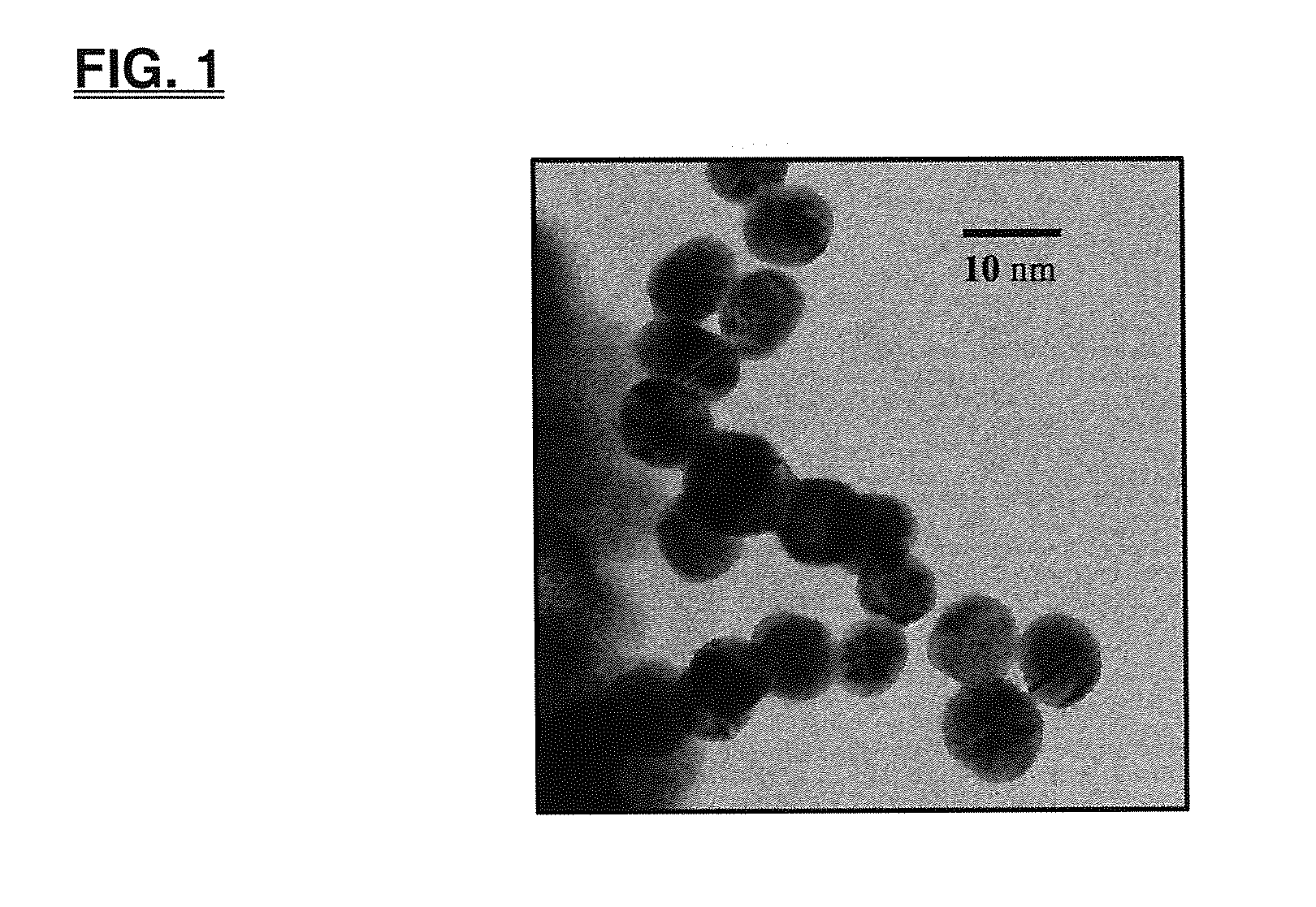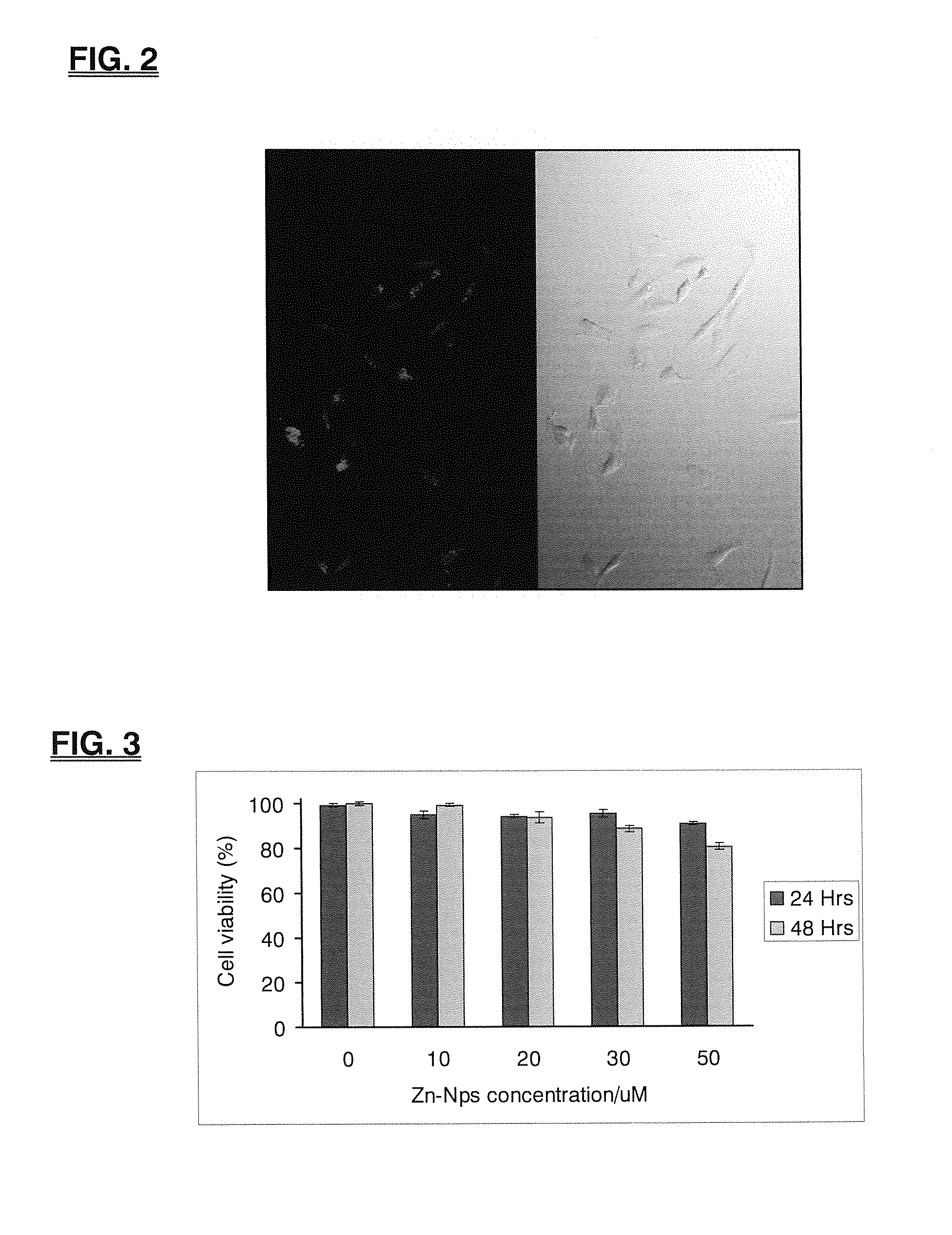Targeting Intracellular Copper Ions for Inhibiting Angiogenesis Using Nanoparticles of Ternary Inorganic Metal Sulfide M1M2S4 (M1, independently, is Mg, Ca, Mn, Fe, or Zn; M2 = Mo or W) Compounds to Treat Metastatic Cancer
a technology of inorganic metal sulfide and nanoparticles, which is applied in the direction of capsule delivery, microcapsules, drug compositions, etc., can solve the problems of inability to meet high expectations, limited efficacy, and inherent or acquired resistance, so as to reduce intercellular copper concentration, reduce cancer cells and/or vascular endothelial cells, and reduce migration of said cancer
- Summary
- Abstract
- Description
- Claims
- Application Information
AI Technical Summary
Benefits of technology
Problems solved by technology
Method used
Image
Examples
example 1
[0037]The cell viability assay was carried out using the MTT method. HuVEC cells were seeded in a 96-well plate at a density of 1×104 cells per well with endothelial cell basal growth medium-2 (EBM-2) medium containing 10% FBS (fatal bovine serum) plus 1% penicillin-streptomycin and incubated for 5 hours at 37° C. in an atmosphere of 5% CO2 and 95% air to allow cells to attach to the surface. Cells in each well were then incubated with 100 μL of fresh medium containing various concentrations of the nanoparticles for 24 hours and 48 hours. Control wells contained the same medium without nanoparticles. Each concentration was tested in replicates of three. At the end of the incubation period, 10 μL of 5 mg / mL 3-(4,5-dimethylthiazol-2-yl)-2,5-diphenyltetrazolium bromide (MTT) was added to each well and incubated for another 3 hrs. Then 100 μl of detergent reagent was added to each well and incubation was continued for another 4 hrs at 37° C. Finally the absorbance was determined at 570 ...
example 2
[0039]Nanoparticles of ZnMoS4 and M1M2S4 (M1, independently, is Mg, Ca, Mn, or Fe; M2=Mo or W) compounds inhibit endothelial cell tube formation in the in vitro model of angiogenesis. All these compounds can act to lower the copper concentration in the endothelial cells used in this model study as well as the copper concentration in the culture media by the ion-exchange with the divalent ion in the ternary compounds via the following reaction:
Cun+ (n=1 or 2)+M1M2S4→CuM2S4+M12+.
Since copper is a required co-factor for many angiogenesis growth factors including VEGF, bFGF, angiogenin in the formation of endothelial cell tubes, the angiogenesis is therefore inhibited.
[0040]Further testing was conducted as follows:
[0041]The tube formation assay is an in vitro a model of angiogenesis commonly used to measure the ability of endothelial cells to form “tubes” (i.e. three-dimensional structures that resemble vessel walls). Tube formation studies were conducted in a 96-well plate format using...
example 3
[0044]nanoparticles of ZnMoS4 and M1M2S4 (M1, independently, is, Mg, Ca, Mn, or Fe; M2=Mo or W) compounds decrease the migration of Huvec endothelial cells. Endothelial cell migration is essential to angiogenesis. Endothelial cell migration is directionally regulated by chemotactic, hapotactic, and mechanotactic stimuli and further involves degradation of extracellular matrix to enable progression of the migrating cells. An in vitro migration bioassay called the Boyden chamber assay was used to study the effect of nanoparticles on the migration of Huvec endothelial cells. Specifically, Huvec cells were grown in EGM-2 growth medium in 35 mm tissue culture dish until 80-90% confluent. The cells were starved 24 hours in EBM-2 basal medium prior to harvesting, counting and resuspending at 1×106 cells / ml in EBM-2 basal medium. 50 ul of cell suspensions were added to the top chamber, along with any listed angiogenesis inhibitors, a low dose of nanoparticles (10 ng / ml), a high dose of nano...
PUM
 Login to View More
Login to View More Abstract
Description
Claims
Application Information
 Login to View More
Login to View More - R&D
- Intellectual Property
- Life Sciences
- Materials
- Tech Scout
- Unparalleled Data Quality
- Higher Quality Content
- 60% Fewer Hallucinations
Browse by: Latest US Patents, China's latest patents, Technical Efficacy Thesaurus, Application Domain, Technology Topic, Popular Technical Reports.
© 2025 PatSnap. All rights reserved.Legal|Privacy policy|Modern Slavery Act Transparency Statement|Sitemap|About US| Contact US: help@patsnap.com



